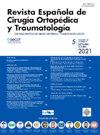[翻译文章] 皮质扣固定治疗肱二头肌远端断裂后的功能评估--体力劳动者和非体力劳动者有区别吗?
Q3 Medicine
Revista Espanola de Cirugia Ortopedica y Traumatologia
Pub Date : 2025-05-01
DOI:10.1016/j.recot.2025.02.012
引用次数: 0
摘要
本研究旨在比较体力劳动者和非体力劳动者在肱二头肌远端肌腱修复后的临床和功能结果。方法回顾性比较57例肱二头肌远端肌腱断裂,分为体力劳动者(24肘)和非体力劳动者(33肘),采用单切口皮质扣干涉螺钉固定治疗。纳入病例至少有3个月的随访,术后x光检查并签署知情同意书。结果体力劳动者旋前和屈曲强度高于非体力劳动者(p值分别为0.192和0.878)。9名患者表现出旋前和旋前活动范围的丧失,这与较差的功能评分相关。非体力劳动者的功能得分往往更高。异位骨化10例,肱外侧皮神经失用20例;其中一个两者都有。他们中的大多数人都完全康复了。结论根据临床评价和术后评分,手术可获得良好至优异的中期功能效果。然而,体力劳动者和非体力劳动者之间没有任何差异。本文章由计算机程序翻译,如有差异,请以英文原文为准。
[Artículo traducido] Evaluación funcional después de la fijación con botón cortical para roturas del bíceps distal: ¿existe alguna diferencia entre trabajadores manuales y no manuales?
Background
This study aims to compare clinical and functional results after distal biceps tendon repair in manual workers vs. non-manual workers.
Methods
This is a retrospective comparative study which refers to 57 cases with distal biceps tendon rupture, divided in manual workers (24 elbows) and non-manual workers (33), that were treated by a single incision with cortical button and interference screw fixation. Included cases have a minimum of 3 months follow-up, post-operative X-ray and signed informed consent for the investigation.
Results
Supination and flexion strength was higher in manual workers vs. non-manual workers (p-value = 0.192 and 0.878, respectively). Nine patients showed loss of range of motion, concerning supination and pronation, and this was correlated to worse functional scores. Functional scores tend to be superior in non-manual workers. Ten patients had heterotopic ossification and 20 patients reported lateral antebrachial cutaneous nerve neuropraxia; one had both. Most of them had a full recovery.
Conclusion
According to clinical evaluation and post-operative scores, the performed surgical procedure provides good to excellent mid-term functional results. Nevertheless, there were not any differences between manual or non-manual workers.
求助全文
通过发布文献求助,成功后即可免费获取论文全文。
去求助
来源期刊

Revista Espanola de Cirugia Ortopedica y Traumatologia
Medicine-Surgery
CiteScore
1.10
自引率
0.00%
发文量
156
审稿时长
51 weeks
期刊介绍:
Es una magnífica revista para acceder a los mejores artículos de investigación en la especialidad y los casos clínicos de mayor interés. Además, es la Publicación Oficial de la Sociedad, y está incluida en prestigiosos índices de referencia en medicina.
 求助内容:
求助内容: 应助结果提醒方式:
应助结果提醒方式:


